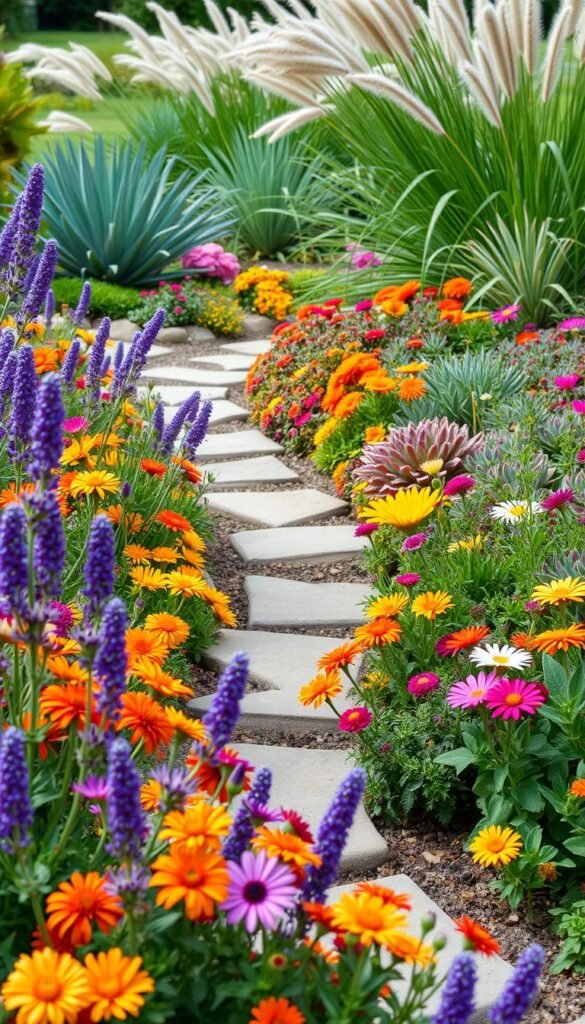Creating a vibrant outdoor space doesn’t have to feel like a second job. If your schedule leaves little room for pruning and watering, smart design choices can help you cultivate beauty without the constant effort. The secret lies in selecting resilient plants and arranging them thoughtfully to work with your lifestyle, not against it.
Imagine stepping outside to a burst of color that thrives even when life gets hectic. By focusing on drought-tolerant species and self-sufficient perennials, you’ll spend less time fussing and more time enjoying your sanctuary. For example, incorporating tough yet beautiful plants like sedum or hostas ensures your beds stay lively with minimal intervention.
This approach isn’t just about saving time—it’s about creating a space that feels intentional and inviting. Whether you’re working with a cozy balcony or a sprawling yard, strategic layouts and proper soil preparation reduce upkeep while maximizing visual impact. You’ll discover how mulch can suppress weeds, and why grouping plants with similar needs keeps maintenance simple.
Ready to transform your outdoor area? Let’s explore design strategies and plant picks that deliver lasting charm without demanding your weekends. You’re about to learn how a little planning today can yield seasons of effortless enjoyment.
Introduction: Discovering a Low-Maintenance Garden Approach
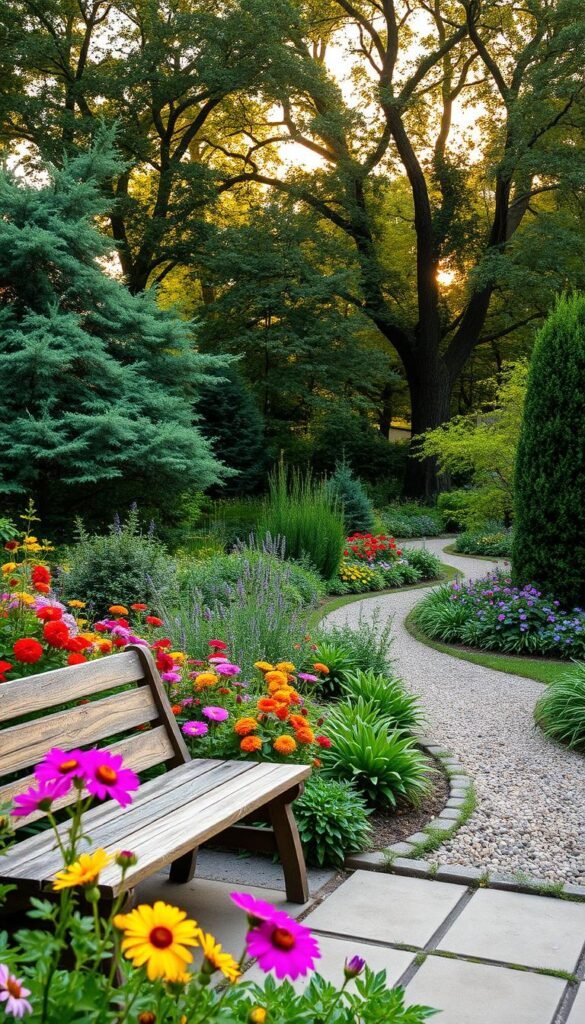
Ever wish your outdoor space could thrive with minimal effort? Start by observing what makes your plot unique. Sunlight angles, soil texture, and water drainage patterns shape what will grow best. These natural conditions become your roadmap for success.
Understanding Your Garden’s Unique Needs
Grab a notebook and track sunlight over three days. Note where shadows fall and for how long. Test your soil using a $7 kit from any gardening store—clay, sand, or loam? This knowledge helps you pick plants that want to grow there.
| Factor | Ideal Condition | Adaptation Tips |
|---|---|---|
| Sunlight | 6+ hours daily | Use shade-loving plants in dim areas |
| Soil Type | Well-draining loam | Mix compost into clay or sandy soils |
| Drainage | 1 inch per hour | Raise beds in waterlogged zones |
Setting Realistic Expectations for Time and Effort
Be honest about your schedule. If weekends are packed, aim for plants needing monthly care instead of weekly pruning. Match your climate zone to species that survive local weather swings naturally. A desert-native lavender will outlast tropical impatiens in arid regions.
Remember: Your space should relieve stress, not create it. Start small with three hardy varieties before expanding. Celebrate what grows well rather than fighting stubborn spots. With smart planning, you’ll create a living retreat that respects both nature and your calendar.
Choosing the Right Plants for Minimal Upkeep
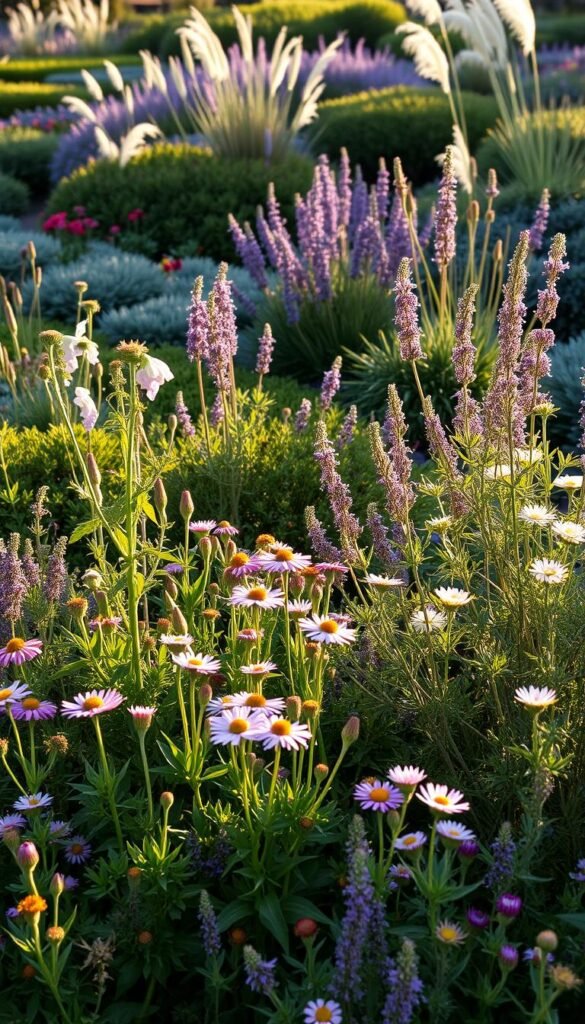
Smart plant choices act as your garden’s backbone, cutting chores while keeping beauty intact. Focus on varieties that work smarter, not harder—those needing little fuss after settling into their ideal spots.
Why Perennials Outshine Annuals
Perennials like lavender or black-eyed Susans return yearly, saving you replanting time. They develop deeper roots over seasons, making them drought-resistant. Unlike annuals needing constant replacement, these plants multiply naturally, filling gaps without extra cost.
Evergreen Shrubs: Your Year-Round Allies
Boxwood and juniper shrubs add structure through all seasons. Once established, they rarely need pruning or watering. Their dense foliage blocks weeds, reducing maintenance further.
Native Plants: Nature’s Perfect Fit
Local species like coneflowers thrive in your region’s soil and weather. They’ve adapted to resist pests and survive rainfall patterns. Check nearby nurseries or native plant lists for options suited to your area.
Pro tip: Start swapping annuals for perennials gradually. Add three native plants each spring—soon, your space becomes self-sufficient. This shift cuts watering by 40% and eliminates fertilizer needs in many cases.
Expert Guidance on Designing a Small, Easy-Care Garden
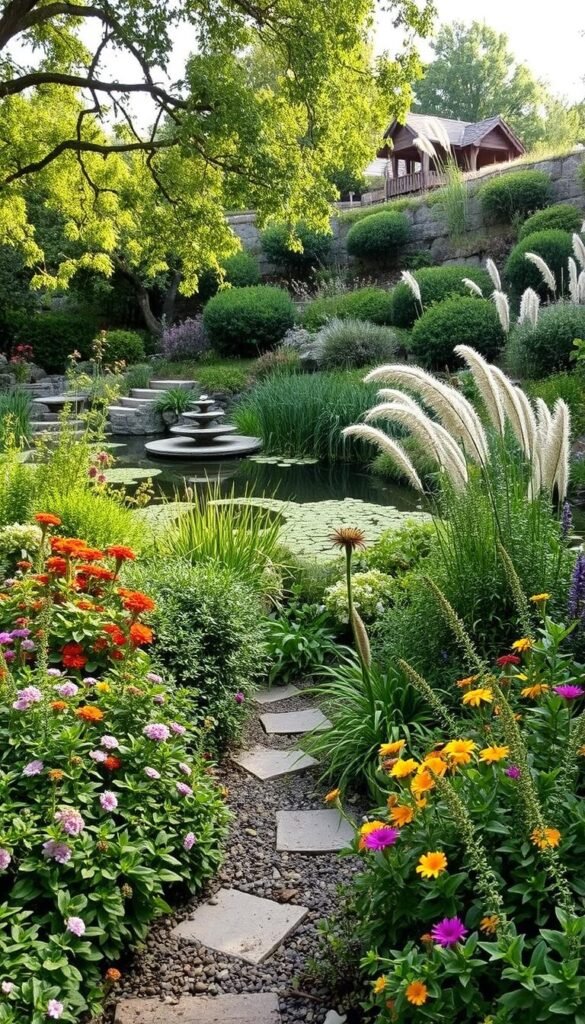
Designing an effortless outdoor retreat begins with embracing simplicity. Crowded layouts create constant upkeep, while strategic minimalism lets nature do the heavy lifting. Focus on three elements: purposeful plant groupings, durable materials, and breathing room between features.
Simplifying with Natural Landscaping Elements
Naturalistic designs work with existing ecosystems instead of forcing artificial order. Let ornamental grasses sway freely rather than shearing them into perfect spheres. Allow groundcovers to spill over pathways, creating soft edges that suppress weeds naturally.
| Formal Style | Natural Approach | Time Saved Monthly |
|---|---|---|
| Precise hedges | Free-form shrubs | 3 hours |
| Annual flower beds | Self-seeding perennials | 5 hours |
| Manicured lawn | Clover meadow | 4 hours |
Create focal points using bold elements like a weathered stone bench or single specimen tree. These anchors draw the eye without cluttering your space. Pair them with textures that age gracefully—think rusted steel planters or cedar mulch that enriches soil as it decomposes.
This approach isn’t about neglect, but intelligent restraint. By mimicking how plants grow wild, you’ll spend weekends relaxing in your sanctuary rather than maintaining it. Your area becomes a living ecosystem that thrives on its own terms.
Embracing Container Gardening and Accent Planters
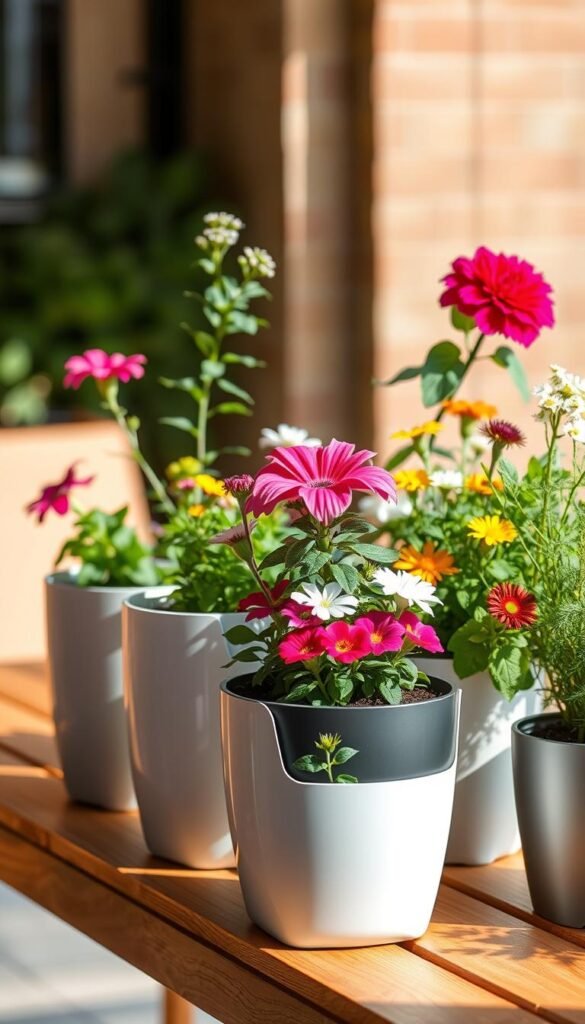
Potted plants offer flexibility but often demand more attention than ground beds. Focus on quality over quantity—one striking planter creates drama without becoming a chore. The key lies in choosing vessels that work with nature’s rhythms, not against them.
Tips for Selecting Self-Watering Containers
Oversized containers store more soil moisture, letting roots drink deeply between watering sessions. Materials matter: resin or fiberglass pots retain humidity better than porous clay. For hot summers, consider double-walled designs that insulate against heat stress.
| Material | Water Retention | Best For |
|---|---|---|
| Resin | High | All climates |
| Metal | Medium | Shaded areas |
| Concrete | Low | Humid regions |
Self-watering systems with built-in reservoirs cut chores by 60%. Fill them weekly, and capillary action keeps soil evenly moist. Pair these with drought-tolerant succulents or herbs like rosemary that thrive on neglect.
Position planters where morning dew collects naturally—near roof edges or under tree canopies. Avoid afternoon sun exposure that bakes soil dry. A premium potting mix blended with water crystals gives roots consistent hydration, while slow-release fertilizers feed for months.
Remember: Your container should enhance your space, not enslave you. Choose one showstopper filled with resilient varieties, and let it anchor your design effortlessly.
Watering and Weed Control Strategies for Busy Gardeners
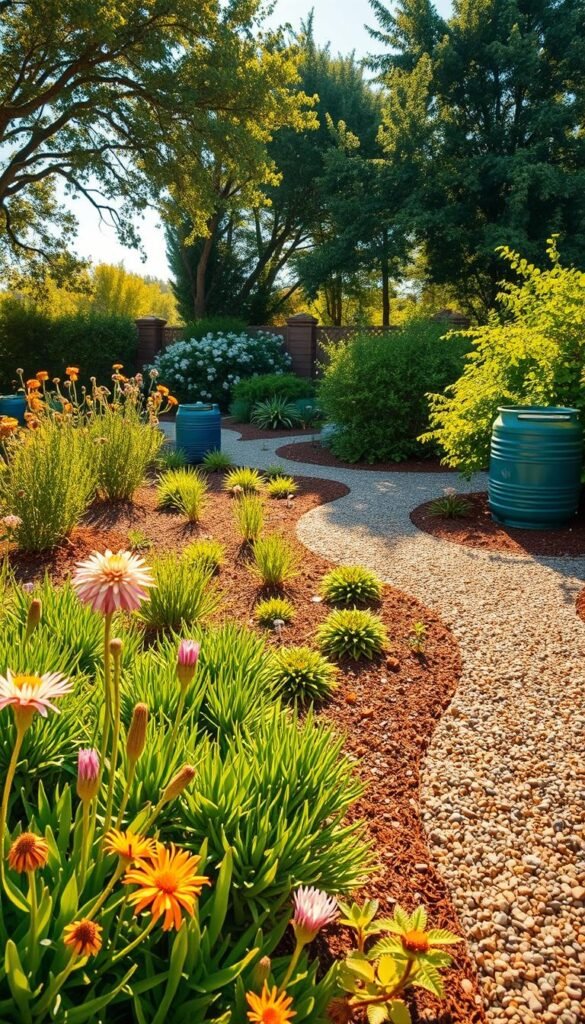
Taming weeds and optimizing hydration doesn’t require constant attention—just smart systems. By combining strategic materials with water-wise practices, you’ll create a self-regulating ecosystem that thrives with minimal input.
Utilizing Mulch, Gravel, and Irrigation Systems
Mulch acts as a superhero cape for your soil, smothering unwanted growth while locking in moisture. Organic options like bark decompose slowly, enriching earth as they break down. Inorganic choices like crushed stone offer permanent coverage for pathways or succulent beds.
| Type | Best Use Cases | Longevity |
|---|---|---|
| Wood Chips | Flower beds, shrubs | 2-3 years |
| Gravel | Pathways, xeriscapes | 10+ years |
| Straw | Vegetable patches | 1 season |
Apply a 3-inch layer around plants, keeping it 2 inches from stems to prevent rot. Pair this with drip lines that deliver water straight to roots—a setup that cuts watering time by 50% compared to sprinklers.
Reducing Maintenance with Drought-Tolerant Varieties
Plants like lavender and yucca laugh at dry spells once established. Their secret? Deep root systems that tap into groundwater reserves. Check plant tags for terms like “xeric” or “water-wise” when shopping.
Group moisture-loving species separately from arid-adapted ones. This zoning lets you target hydration where it’s needed most, avoiding wasteful overwatering. Over time, these choices build resilience against both droughts and busy schedules.
Innovative Ideas to Maximize Small Outdoor Spaces
Limited square footage becomes an opportunity for creativity when approached strategically. Vertical surfaces and layered designs unlock hidden potential, letting you grow more while keeping upkeep manageable. Start by assessing walls, railings, and fences—these often-overlooked spaces hold the key to expanding your green thumb territory.
Growing Up Instead of Out
Install wall-mounted planters with trailing vines like clematis or morning glories. These climbers add height without floor space. For herbs or succulents, try pocket gardens made from recycled pallets—they turn blank walls into living art. Pair these with hanging baskets of petunias for cascading color.
Border Designs That Work Harder
Define edges using mixed-height shrubs and perennials. Place taller plants like dwarf hydrangeas at the back, mid-sized lavender in the middle, and creeping thyme along the front. This tiered approach creates depth while blocking weeds naturally.
| Vertical System | Best Plants | Maintenance Level |
|---|---|---|
| Trellis | Jasmine, peas | Low |
| Pocket Wall | Herbs, sedums | Medium |
| Hanging Tower | Strawberries, pansies | High |
Dense groupings in raised beds leave no room for unwanted growth. Combine ornamental grasses with flowering ground covers—their intertwined roots form a living mulch. For pathways, use crushed granite between planting zones; it stays put during rains and deters weeds.
Rotate container clusters seasonally to refresh your layout. A rolling plant caddy lets you shift citrus trees into sun or shade as needed. These smart solutions prove that every inch counts when designing thriving, time-saving spaces.
Small Flower Garden Ideas for Busy Gardeners: Low-Maintenance Options
Transform your outdoor area into a self-sustaining spectacle with blooms that practically care for themselves. The magic lies in selecting varieties that bloom relentlessly while shrugging off common stressors like drought or pests.
Flower Power Without the Fuss
Coneflowers stand out as rockstars of resilience. Their daisy-like petals burst with color from June through September, requiring only occasional deadheading. Plant them alongside beginner-friendly options like cosmos, which drop seeds each fall to ensure fresh volunteers every spring.
| Plant | Bloom Period | Care Needs |
|---|---|---|
| Coneflower | 4 months | Water monthly |
| Cosmos | 6 months | None after planting |
| Peony | Decades | Divide every 10 years |
Peonies prove time-tested champions, thriving in the same spot for 50+ years with minimal intervention. Their lush blooms resist slugs and spring frosts, making them ideal for forgetful waterers.
Layer these varieties for nonstop color. Early peony blossoms hand off to summer coneflowers, while cosmos fireworks last until frost. Add ninebark shrubs for burgundy foliage that complements every hue.
Choose pollen-rich varieties like purple coneflowers to attract butterflies. Their sturdy stems need no staking, and spent flowers provide winter interest. You’ll craft a space that looks meticulously tended—even when life keeps you away.
Creating Lively Garden Beds for Year-Round Color
Your garden beds can become a living calendar, shifting hues and textures with each passing month. The trick lies in layering plants that peak at different times while contributing structure during their “off-seasons.” Start by sketching a timeline of bloom periods and foliage changes to visualize how colors will transition.
Seasonal Planting Strategies for Continuous Bloom
Pair early risers like crocus and daffodils with late-show stars such as asters. Spring bulbs push through winter mulch just as summer perennials like daylilies begin stretching their leaves. When autumn arrives, switch focus to sedum and ornamental grasses that hold their form until snowfall.
| Season | Plant | Color Contribution | Care Level |
|---|---|---|---|
| Winter | Red Twig Dogwood | Crimson stems | Low |
| Spring | Bleeding Heart | Pink blooms | Medium |
| Summer | Coneflower | Purple petals | Low |
| Fall | Japanese Maple | Fiery foliage | Medium |
Incorporate plants with multi-season appeal. Ninebark shrubs offer white spring flowers, burgundy summer leaves, and peeling winter bark. Winterberry holly dazzles with red berries after losing its leaves, creating striking contrast against snow.
Group plants in triangular clusters of three for visual impact. Place taller varieties at the back of beds, mid-height fillers in the center, and spillers like creeping phlox along edges. This arrangement ensures every layer contributes to the display while suppressing weeds naturally.
Refresh beds twice yearly with compost instead of replanting. A 2-inch mulch layer in spring retains moisture and simplifies cleanup. For lasting vibrancy, choose self-cleaning flowers like geranium ‘Rozanne’ that drop spent blooms without deadheading.
Balancing Hardscaping With Natural Planting Elements
What if your yard could look polished without the endless chores? Traditional grassy areas often demand more attention than they’re worth. Swap turf for textured alternatives that thrive on neglect while adding visual depth to your space.
Integrating Gravel, Mulch, and Lawn Alternatives
Gravel pathways create crisp lines while suppressing weeds naturally. Pair them with drought-tolerant sedums or thyme that spill softly over edges. For areas needing greenery, clover offers a lush carpet that stays green with minimal watering—no mowing required.
Bare ground becomes a non-issue with 3 inches of mulch. It locks in moisture and breaks down slowly, feeding soil microbes. Check out this low-maintenance design using layered gravel and ornamental grasses for inspiration.
Struggling with compacted soil? Replace high-maintenance grass with creeping juniper. Its evergreen foliage thrives in poor conditions while anchoring slopes. You’ll gain texture and erosion control without weekly upkeep.

